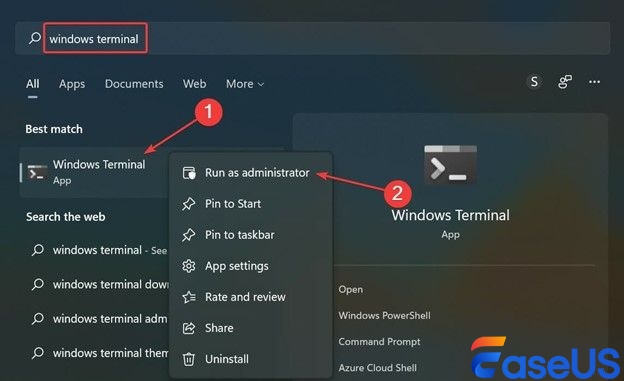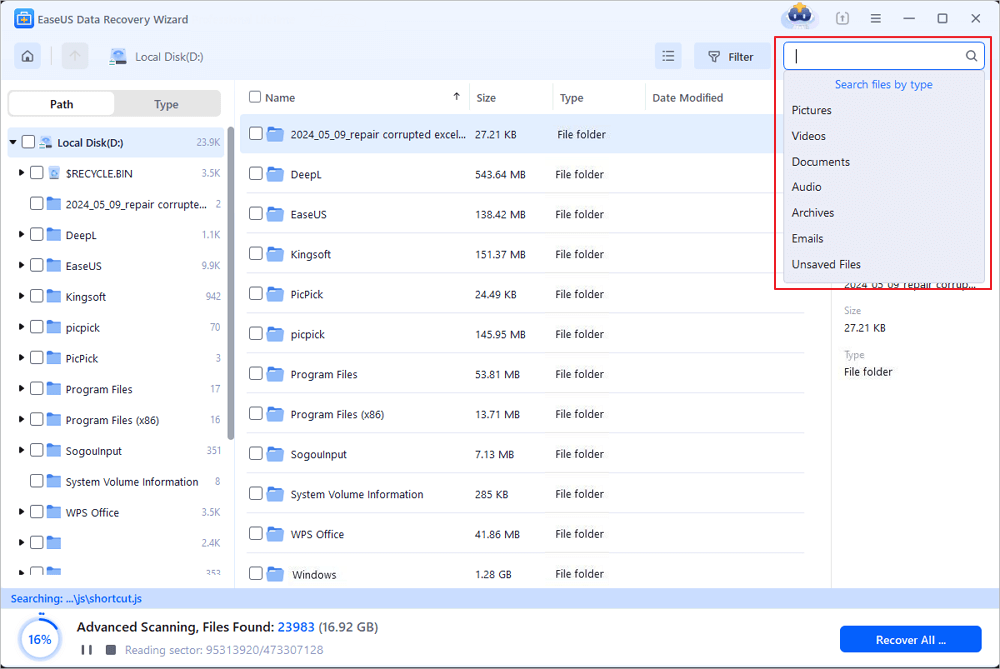-
![]() Top 9 Ways to Recover Folders Disappeared from Desktop Mac and Windows 10/8/7
Top 9 Ways to Recover Folders Disappeared from Desktop Mac and Windows 10/8/7 December 12,2025
December 12,2025 6 min read
6 min read -
![]()
-
![]()
-
![]()
-
![]() How to Recover Permanently Deleted Emails in Outlook 2018/2017/2016/2010/2007/2003
How to Recover Permanently Deleted Emails in Outlook 2018/2017/2016/2010/2007/2003 December 12,2025
December 12,2025 6 min read
6 min read -
![]()
-
![]() Files Automatically Encrypted, How to Remove Encryption from Files
Files Automatically Encrypted, How to Remove Encryption from Files December 12,2025
December 12,2025 6 min read
6 min read -
![]()
-
![]() How to Recover Permanently Deleted Photos from Gallery Without Backup
How to Recover Permanently Deleted Photos from Gallery Without Backup December 18,2025
December 18,2025 6 min read
6 min read -
![]() [Solved] Dashcam Footage Missing? How to Recover Missing Dashcam Footage
[Solved] Dashcam Footage Missing? How to Recover Missing Dashcam Footage December 12,2025
December 12,2025 6 min read
6 min read
Page Table of Contents
PAGE CONTENT:
Windows 11 startup folders are essential for controlling which apps run at startup. Knowing how to manage startup folders is important for streamlining your starting process by removing unneeded applications or ensuring that vital programs are ready to run when you log in.
This article will explain Windows 11 startup folders, how to change and troubleshoot startup applications, and how to add new apps to your startup list. You'll learn how to optimize your startup experience, guaranteeing a smoother and more effective workflow every time you turn on your device.
Windows 11 Startup Folder: What Can It Do
- Windows startup folder determines which programs start immediately when you boot.
- Managing this folder's apps may considerably affect system startup and performance.
- If your computer boots slowly, too many apps may be set to launch automatically at startup.
Customizing the Windows 11 starting folder ensures that only critical programs launch automatically, optimizing your PC. Startup time and system resources are freed up, making computing more smooth and efficient. Understanding this feature lets you adjust your computer's performance by adding or removing startup utilities.
How to Change Startup Programs in Windows 11
Windows 11 startup program management improves system speed and boot time. Unnecessary startup programs might slow down your computer, while important ones can boost your productivity by being accessible. Fortunately, Windows 11 gives several starting program controls. This section will show you how to adjust starting programs using the Task Manager and Settings app.
Method 1. Using Task Manager
The Task Manager is a comprehensive tool for managing your computer's programs, including starting ones. Task Manager lets you activate or turn off starting programs; here's how:
Step 1. Right-click the Start menu on the taskbar and choose "Task Manager."

Step 2. In Task Manager, choose "Startup." Find the Gauge icon in the lower left corner and click it to access this tab. It opens the Startup tab.

Step 3. The Startup tab lists applications that start with your computer. To deactivate an application, select "Deactivate" from the right-click menu or select "Enable" from the right-click menu to enable it.
Step 4. After making modifications, ensure each program is enabled or disabled. Close the Task Manager when you are done.
Method 2. Using the Settings App
The Settings app in Windows 11 offers a more user-friendly way to manage your startup programs. Here's how to do it:
Step 1. Click Start, then "Settings." It may not be listed, so utilize the search box.
Step 2. Open Settings and select "Apps" from the left sidebar.

Step 3. Under Apps, click "Startup." The list of apps your computer can launch will appear.
Step 4. Each app has a toggle option. Turn the switch "On or Off" to activate or disable the application during startup. Only programs you've toggled on will start immediately when you boot your computer.
How to Fix Windows 11 Startup Folder Not Working
Problems with the Windows 11 Startup Folder can be annoying, particularly when Windows 11 start menu not working. It is critical to back up your information before continuing with troubleshooting to guarantee that no data loss occurs. The following are three effective ways to fix the issue:
Fix 1. Disable User Account Control (UAC)
User Account Control (UAC) is intended to prevent unauthorized modifications to your system. However, it may sometimes conflict with launch programs. Disabling UAC momentarily may remedy the problem.
Step 1. To access the Search menu, press "Windows + S," then type Change user account control settings and choose the appropriate result.
Step 2. Drag the slider to the lowest position, labeled "Never notify," then click "OK."

Step 3. When the UAC window comes, choose "Yes" to confirm.
Fix 2. Manually Add the Shortcut to the Startup Folder
If your program's shortcut is not in the appropriate Startup location, you may manually add it:
Step 1. Find the folder with the "Application (.exe) file" for the program's launch.

Step 2. Select the "launcher" and click the Copy symbol in the command bar.
Step 3. To access the Common Startup folder, press "Windows + R," type shell startup, then enter.
Step 4. Right-click on the Startup folder and choose "Paste."

Step 5. If asked, click "Continue" to confirm your changes and restart the device

Fix 3. Run SFC Scan and DISM Tool
The Startup Folder could stop working due to corrupted system files. System File Checker (SFC) scans with DISM may help:
Step 1. Search "Windows Terminal" in the bar, right-click the result, and choose "Run as administrator."

Step 2. Run the DISM commands:
- Enter DISM /Online /Cleanup-Image /CheckHealth.
- Press Enter for DISM /Online /Cleanup-Image /ScanHealth.
- Last, run DISM /Online /Cleanup-Image /RestoreHealth.
Step 3. Type sfc /scannow and press Enter to find and repair damaged system files after DISM.

We understand that repairing your Startup Folder might fail and cause data loss. In this situation, the EaseUS Data Recovery Wizard comes into play. This advanced tool recovers deleted files due to system faults, crashes, accidental deletion, and other issues. Its simple interface lets even beginners restore deleted data quickly.
Key features:
- Recovering lost data from various storage media, including hard discs, SSDs, and USB drives.
- The see Function allows you to see files before recovery to confirm that you have recovered the proper data.
- Provides rapid and thorough scan options for various data loss circumstances.
Step 1. Select a folder to scan for lost files
Launch EaseUS Data Recovery Wizard. Double click "Select Folder" to browse the the location where you lost the folder and click "OK" to scan the lost folder.

Step 2. Find and preview found files in the lost folder
If you remember the folder name, type the folder name in search box to quickly find the lost files. Then, open the found folder and double-click to preview scanned files. Or you can use the Filter feature to find a certain type of files.

Step 3. Recover and save the lost folder
Last, select the folder and files you need, click "Recover" and choose a new & secure location on your PC or cloud storage like OneDrive, Google Drive, or Dropbox to keep the recovered data.

Please share this information on social media to help others in similar situations.
How to Add Programs to Startup Windows 11
You may configure Windows 11 to launch certain programs automatically when the computer boots up by adding them to the startup folder. Here is how it's done:
Step 1. Open Settings by clicking the Start button and then selecting Settings from the menu.
Step 2. In the Settings app, choose "Apps" from the left sidebar.
Step 3. In the right pane, click the "Startup" button.
Step 4. A list of all applications will appear, each with a toggle next to it. Turn the toggle on for the apps you wish to launch automatically when Windows wakes up, and turn it off for programs you don't want to launch.

- Notice:
- This method lets you control which programs open at startup and tailor system performance to your specific requirements.
Summary
This article covers Windows 11 startup folders' importance in system performance, management, troubleshooting, and adding apps to your startup list in this post. Controlling which programs run at startup improves computer performance and user experience. The techniques presented will help you fully manage your starting process, whether you want to stop unneeded programs from slowing down boot time or ensure vital apps are available when you log in.
Finally, download EaseUS Data Recovery Wizard if you lose data or need to recover vital files due to a starting problem or other cause. This software program restores lost data rapidly and efficiently, making it essential.
Windows 11 Startup Folders FAQ
The following are the most commonly asked questions about Windows 11 startup folders:
1. How do I add programs to the Startup folder in Windows 11?
Please navigate to the Startup folder, copy the program's shortcut, and paste it into the folder.
2. Where do I change Startup programs in Windows 11?
You can manage startup programs through the Task Manager's "Startup" tab or the "Startup" section in the Settings app under "Apps."
3. How do I select which folders appear on Startup Windows 11?
To select folders for startup, manually add their shortcuts to the Startup folder or manage folder settings in File Explorer.
Was this page helpful?
-
Jaden is one of the editors of EaseUS, who focuses on topics concerning PCs and Mac data recovery. Jaden is committed to enhancing professional IT knowledge and writing abilities. She is always keen on new and intelligent products.…

20+
Years of experience

160+
Countries and regions

72 Million+
Downloads

4.9 +
Trustpilot Score


Free Data
Recovery Software
Recover data up to 2GB for free!













